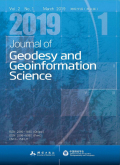- 钛学术文献服务平台 \
- 学术期刊 \
- 基础科学期刊 \
- 天文学、地球科学期刊 \
- 测绘学报(英文版)期刊 \
null
Detecting Droughts in Southwest China from GPS Vertical Position Displace-ments
基本信息来源于合作网站,原文需代理用户跳转至来源网站获取
摘要:
The solid Earth responds elastically to terrestrial water storage ( TWS) changes. Here global positioning system ( GPS) vertical position data at 31 stations from the crustal movement observation network of China ( CMONOC) from August 2010 to December 2016 are used to detect droughts in Southwest China. Monthly GPS vertical position displacements respond negatively to precipitation changes and TWS changes observed by gravity recovery and climate experiments ( GRACE ) as well as river water level variations. GPS vertical position anomalies ( the non-seasonal term) are well correlated negatively ( correlations of about-0.70) with the commonly used meteorological composite index ( CI) in China and the GRACE drought severity index ( GRACE-DSI),but less correlated with the standardized precipitation evapotranspiration index (SPEI). Compared to CI, GPS vertical position anomalies have the advantage of detecting droughts caused by abrupt precipitation deficits in a short time. GRACE-DSI is less accurate in drought monitoring for some periods due to the missing data, while the severity of abrupt precipitation absent in some cases can be overestimated from SPEI with big variability. This study shows the reliability and advantages of GPS data in drought monitoring.

推荐文章
期刊_丙丁烷TDLAS测量系统的吸收峰自动检测
带间级联激光器
调谐半导体激光吸收光谱
雾剂检漏 中红外吸收峰 洛伦兹光谱线型
不同盐度、温度及光照对漂浮浒苔生理生态的影响
浒苔
盐度
温度
光照
生理生态
期刊_联合空间信息的改进低秩稀疏矩阵分解的高光谱异常目标检测
高光谱图像
异常目标检测 低秩稀疏矩阵分解 稀疏矩阵 残差矩阵
内容分析
关键词云
关键词热度
相关文献总数
(/次)
(/年)
引文网络
引文网络
二级参考文献 (360)
共引文献 (421)
参考文献 (31)
节点文献
引证文献 (0)
同被引文献 (0)
二级引证文献 (0)
1919(1)
- 参考文献(0)
- 二级参考文献(1)
1930(1)
- 参考文献(0)
- 二级参考文献(1)
1931(1)
- 参考文献(0)
- 二级参考文献(1)
1948(3)
- 参考文献(0)
- 二级参考文献(3)
1954(1)
- 参考文献(0)
- 二级参考文献(1)
1957(1)
- 参考文献(0)
- 二级参考文献(1)
1968(2)
- 参考文献(0)
- 二级参考文献(2)
1972(2)
- 参考文献(1)
- 二级参考文献(1)
1975(1)
- 参考文献(0)
- 二级参考文献(1)
1977(1)
- 参考文献(0)
- 二级参考文献(1)
1980(4)
- 参考文献(0)
- 二级参考文献(4)
1981(1)
- 参考文献(0)
- 二级参考文献(1)
1982(1)
- 参考文献(0)
- 二级参考文献(1)
1984(1)
- 参考文献(0)
- 二级参考文献(1)
1985(6)
- 参考文献(0)
- 二级参考文献(6)
1986(2)
- 参考文献(0)
- 二级参考文献(2)
1987(2)
- 参考文献(0)
- 二级参考文献(2)
1990(2)
- 参考文献(0)
- 二级参考文献(2)
1991(4)
- 参考文献(0)
- 二级参考文献(4)
1992(2)
- 参考文献(0)
- 二级参考文献(2)
1993(6)
- 参考文献(0)
- 二级参考文献(6)
1994(5)
- 参考文献(0)
- 二级参考文献(5)
1995(4)
- 参考文献(0)
- 二级参考文献(4)
1996(5)
- 参考文献(0)
- 二级参考文献(5)
1997(6)
- 参考文献(0)
- 二级参考文献(6)
1998(16)
- 参考文献(1)
- 二级参考文献(15)
1999(2)
- 参考文献(0)
- 二级参考文献(2)
2000(3)
- 参考文献(0)
- 二级参考文献(3)
2001(4)
- 参考文献(0)
- 二级参考文献(4)
2002(16)
- 参考文献(1)
- 二级参考文献(15)
2003(11)
- 参考文献(0)
- 二级参考文献(11)
2004(21)
- 参考文献(0)
- 二级参考文献(21)
2005(11)
- 参考文献(0)
- 二级参考文献(11)
2006(12)
- 参考文献(0)
- 二级参考文献(12)
2007(29)
- 参考文献(1)
- 二级参考文献(28)
2008(20)
- 参考文献(0)
- 二级参考文献(20)
2009(18)
- 参考文献(1)
- 二级参考文献(17)
2010(18)
- 参考文献(2)
- 二级参考文献(16)
2011(21)
- 参考文献(3)
- 二级参考文献(18)
2012(19)
- 参考文献(1)
- 二级参考文献(18)
2013(22)
- 参考文献(2)
- 二级参考文献(20)
2014(29)
- 参考文献(5)
- 二级参考文献(24)
2015(33)
- 参考文献(4)
- 二级参考文献(29)
2016(11)
- 参考文献(2)
- 二级参考文献(9)
2017(7)
- 参考文献(4)
- 二级参考文献(3)
2018(3)
- 参考文献(3)
- 二级参考文献(0)
2020(0)
- 参考文献(0)
- 二级参考文献(0)
- 引证文献(0)
- 二级引证文献(0)
引文网络交叉学科
相关学者/机构
期刊影响力
测绘学报(英文版)
主办单位:
测绘出版社
中国测绘学会
出版周期:
季刊
ISSN:
2096-5990
CN:
10-1544/P
开本:
大16开
出版地:
北京市西城区三里河路50号
邮发代号:
创刊时间:
2018
语种:
eng
出版文献量(篇)
120
总下载数(次)
0
总被引数(次)
9
期刊文献
相关文献
推荐文献

 免费查重
免费查重










